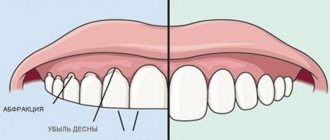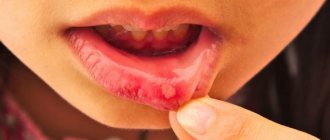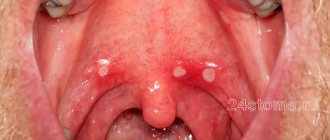Diseases of the oral mucosa include not only those familiar to every dentist, but also diseases such as candidiasis, cheilitis, and stomatitis. The oral mucosa is also important for assessing the general condition of the patient and his immunity. Indeed, often the oral mucosa is almost the first place of manifestation of infectious diseases, such as syphilis, tuberculosis, scarlet fever, diphtheria, and gonorrhea. And here the dentist should not only accurately diagnose the infectious disease in order to help the person, but also warn himself so that cross-infection does not occur.
What is stomatitis
Stomatitis is a group of dental diseases that have similar manifestations. The disease looks like inflammation of the oral mucosa, localized on the inside of the cheeks, on the palate, gums, lips, and tip of the tongue. In rare cases, lesions are diagnosed in the pharynx, on the tonsils - such formations are the most difficult to notice.
Typically, stomatitis develops as an independent disease as a result of a sharp drop in immunity, chronic infection, or allergies. The disease is contagious only in rare forms, but if left untreated, it quickly spreads through the mucous membranes of the oral cavity - it can provoke a sharp rise in temperature, causing weakness and prolonged malaise.
Stomatitis also manifests itself as a complication or symptom of other diseases - influenza, gastritis, diabetes, bronchial asthma, HIV infection.
general characteristics
Diseases of the oral mucosa can be infectious, inflammatory, viral or fungal. When an infection enters the oral cavity, the mucous membrane is the first to suffer. It can become inflamed, bleed, and become thinner. Conventionally, such diseases are classified as stomatitis. But besides stomatitis, there are many more problems that lead to deterioration in human health.
In almost all of the diseases described below, the symptoms will be similar: pain, rashes of various types, discoloration of the tissues of the oral cavity.
Oral diseases can be treated by a dentist, ENT specialist or therapist. When the first symptoms appear, you should consult any of these doctors for examination.
Stomatitis: symptoms
Since stomatitis is an inflammatory process, the manifestations of the disease are standard. Dentists identify signs of stomatitis:
- redness, formation of a hyperemic area in the oral cavity;
- swelling, swelling of the affected area;
- the appearance of erosions, ulcers, aphthae;
- itching, burning at the site of ulcer formation;
- gray or yellowish coating along the edges of the canker sores;
- pain when talking, opening the mouth, or touching the mucous membranes of the mouth;
- bleeding due to accidental damage to plaque;
- local temperature increase.
Patients also note an unpleasant taste in the mouth, a putrid odor, and loss of appetite.
Prevention
In general, it is quite difficult to avoid this disease in the presence of predisposing causes; you can only take some general measures to possibly prevent the disease or complication in the form of stomatitis.
Since the herpetic virus, especially in acute primary forms, is extremely contagious, a certain isolation of the patient is required to prevent the spread of infection by airborne droplets and contact. The difficulty here is that there is a rather long incubation period, up to 26 days, and the first signs of stomatitis may escape attention.
Other preventive measures are of a general nature and consist of proper and complete oral hygiene, regular professional cleanings in a dental clinic (removal of soft and hard plaque), timely treatment of mucosal injuries, and measures to generally strengthen the immune system.
Posted in Useful information | Tags: teeth, diabetes, care
Stomatitis: causes
A variety of factors and diseases contribute to the development of stomatitis in adults. For ease of diagnosis, doctors combined the causes of stomatitis into four groups, highlighting the main problem conditions:
- Mechanical injury. Ulcers appear as a result of some irritating factor. Damage can be caused by eating hard foods, poorly installed dentures, tartar buildup, and sharp edges of chipped crowns. Pathogenic microflora enters the damaged area, causing inflammation and active formation of ulcers.
- Chemical or thermal burn. Aggressive chemical agents can be food (citrus fruits), medications, nicotine, incorrectly selected toothpastes or mouth rinses. Thermal burn occurs when consuming excessively hot food or drinks.
- Poor oral hygiene. Failure to comply with regular hygiene procedures, tartar, and plaque provoke the active proliferation of bacterial microflora, which leads to inflammation of the oral mucosa.
- Chronic diseases. In adults, stomatitis develops as a reaction to problems of the gastrointestinal tract, cardiovascular system, due to anemia, endocrine pathologies, and HIV infections.
In addition to the listed categories, the causes of stomatitis can also be internal problems:
- vitamin deficiency, micronutrient deficiency - unbalanced diet, metabolic disorders in the body;
- allergies - of any origin;
- heredity - the individual reaction of the immune system to deteriorating health;
- a general decline in immunity - as a result of serious illnesses.
Unfavorable factors become catalysts for the development of pathology, and external circumstances aggravate the course of the disease.
The variety of causes points to an important point: there is no obvious causative agent of stomatitis. In order for an ulcer to localize, several circumstances must coincide - decreased immunity for any reason, an abundance of pathogenic microflora in the oral cavity, a traumatic agent.
How to get rid of stomatitis and other inflammatory diseases of the oral cavity
Treatment of stomatitis and other inflammatory diseases is usually comprehensive, aimed at alleviating the patient’s condition, eliminating the root cause and risk factors.
Often, inflammation of the oral cavity is painful, accompanied by itching, irritation, and swelling of the mucous membrane. Because of this, patients have difficulty eating. To alleviate the condition, the affected areas are treated with various anesthetic and antiseptic rinses, powders, and solutions. This also prevents possible complications of diseases, for example, the transition of aphthae or foci of inflammation into ulcers, which require more time to heal.
Another important area of treatment is the elimination of local causes of inflammation of the oral mucosa. These include local foci of infection, for example, caries , dental plaque (tartar), traumatic chipped teeth, protruding parts of fillings or dentures [1]. For this purpose, appropriate treatment and professional hygiene are carried out.
And finally, a significant part of therapy is devoted to the diagnosis and elimination of a general disease that can provoke inflammation of the oral cavity (for example, endocrine disorders or chronic diseases of the gastrointestinal tract) [1]. In special cases, antiviral drugs [5], antimycotics [6] and antibiotics [1] are used.
Prevention of stomatitis and other inflammatory diseases includes [7]:
- treatment of major systemic diseases;
- strengthening general immunity: adherence to the principles of a healthy lifestyle, nutrition, giving up bad habits, eliminating hypo- and avitaminosis;
- strengthening local immunity: regular careful hygiene, avoiding injury and irritation of the mucous membrane in the mouth.
Regular individual and professional oral hygiene is a key way to prevent intraoral inflammation. It must include:
- brushing your teeth twice a day, after breakfast and before bed, with a soft-bristled brush and toothpaste;
- the right choice of toothpaste: if you are prone to inflammation of the mouth and gums, as prescribed by a specialist, you should give preference to pastes with anti-inflammatory and antiseptic properties;
- use of antibacterial rinses with anti-inflammatory effects;
- cleaning interdental spaces with dental floss or tape;
- regular visits to the dentist (once every 6 months) for a preventive examination and professional removal of dental plaque.
Types of stomatitis in adults
Effective treatment of stomatitis in adults begins with the diagnosis of pathology. Identifying the provoking factor is one of the main tasks of the dentist. The situation is aggravated by the fact that many reasons are similar - they overlap each other, distorting the clinical picture. For this reason, only experienced doctors treat stomatitis in adult patients.
There are a variety of classifications of stomatitis:
- according to the course - acute periodic, chronic, recurrent;
- by external manifestation - redness, aphthae, erosion;
- by localization - on the lip, on the tongue, on the palate, in the throat.
When diagnosing and selecting a treatment plan, dentists try to take into account the versatility of the disease - the form, causes, degree of damage to the mucous membranes, stage of the disease, and other classification parameters. Based on these factors, it is customary to identify the most popular types of stomatitis in adults:
- aphthous;
- ulcerative;
- herpetic;
- candida;
- prosthetic;
- allergic;
- ray.
Aphthous stomatitis
Aphthous stomatitis is characterized by the appearance of round ulcerative formations covered with necrotic plaque. This is the most common variant of the disease - it occurs in 65-70% of dental patients.
The causes of aphthae formation are viral and bacterial diseases. Localization of ulcers is on almost any mucous tissue of the oral cavity.
Initially, the patient is faced with the fibrinous form, when local blood circulation is disrupted. If left untreated, the disease turns into a necrotic form, accompanied by tissue death, or into a scarring form - the mucosal tissue changes structure.
Ulcerative stomatitis
Ulcerative stomatitis is characterized by the formation of deep, painful ulcers in the mouth. They usually arise due to:
- poor hygiene - a large amount of plaque on the teeth, tartar;
- problems with the gastrointestinal tract - metabolic disorders;
- chemical burns - abuse of especially spicy foods.
Lesions affect the deep layers of tissue, so treatment of ulcerative viral or bacterial stomatitis in adults is carried out only by a dentist according to a carefully developed plan.
A separate type of ulcerative stomatitis is ulcerative-necrotizing gingivitis, Vincent's stomatitis. The cause of the disease is the active proliferation of pathogenic microflora, the influence of spindle bacillus and Vincent's spirochete. The disease is observed against the background of a sharp decrease in immunity and is characterized by reactive development. Patients complain of swelling of the gums, suppuration, pain, putrid breath, and loss of appetite. Without treatment, tissue necrosis progresses and tooth roots are exposed.
Herpes (herpetic) stomatitis
Viral herpetic stomatitis is a contagious variant of the disease provoked by the herpes virus. Transmitted through hygiene items, through negligence, by airborne droplets.
Externally it differs from other types, since the lesions look like fluid-filled blisters before turning into ulcers.
During treatment, the doctor conducts complex therapy, including taking medications.
Candidal stomatitis
The cause of candidal stomatitis is a fungus that causes the appearance of a cheesy coating on the oral mucosa. Underneath the plaque is a swollen, inflamed area. When the formations are removed, the tissue surfaces begin to bleed.
The causes of the disease are decreased immunity and poor hygiene. Treatment requires careful selection of drugs so as not to aggravate the situation.
Prosthetic stomatitis
The pathology is typical only for adult patients, as it is a consequence of improper prosthetics, individual intolerance to the crown material, and poor quality of care for the orthopedic product.
The disease manifests itself as inflammation of the soft tissues around the prosthetic structure, turning into ulcers and erosion.
Allergic stomatitis
A distinctive feature of the disease is dryness and itching in the mouth. This is how increased sensitivity to allergens manifests itself. At the site of the inflamed areas, aphthae and ulcers quickly form. In severe cases, an ulcerative-necrotic form may develop.
Pathology happens:
- acute - single manifestation;
- chronic - with constant relapses and complications.
Treatment requires an integrated approach.
Radiation stomatitis
The reason for the appearance is the patient undergoing radiation therapy or chemotherapy and, as a result, a decrease in immunity. It occurs acutely - with inflammation and ulcers. Requires careful attention from the doctor during treatment to avoid worsening the situation.
Diagnosis of diseases of the oral mucosa
Modern medicine has a wide range of diagnostic tests to make an accurate diagnosis.
Only a doctor can give the correct classification of the disease. For this purpose, he can use the following methods:
- Mucosal smear for microscopic examination;
- Conducting allergy tests;
- Analysis for viral infections (herpes, tonsillitis);
- General examination to identify the primary disease.
Change in structure with fluid accumulation
With such lesions, the structure of the mucous tissue changes so that a cavity filled with liquid is formed inside.
Bubbles and bubbles. They are formed in the epithelial layer or under it, filled with serous or hemorrhagic contents, and can be grouped. The cavity is closed by a thin layer of epithelium, which can break through. Bubbles can group and break quickly. Bubbles form and last longer. Both types of lesions provoke the formation of healing ulcers on the surface of the mucous membranes. They arise due to damage by viruses, traumatic injuries, and disturbances in tissue nutrition.
Ulcers. They can form from blisters or on unchanged mucosa. The cavity is filled with purulent exudate (whitish, yellowish, greenish contents with a pungent odor). They can be deep or superficial, often painful. Indicate an inflammatory process, appear after traumatic damage to the mucous membrane, due to infectious, viral diseases.
Cysts. A formation with dense walls that form a cavity. It is filled with transparent contents (can become purulent, serous, bloody). Appear due to blockage of gland ducts on the mucous membranes or as a symptom of periodontal diseases.
How is the treatment carried out?
Treatment for stomatitis is comprehensive.
- Anesthesia. To eliminate pain, the dentist may prescribe topical medications containing lidocaine or analgesics.
- Antiviral therapy. If the disease is caused by a herpes virus, the doctor prescribes antiviral drugs of the appropriate group of effects.
- Antibacterial therapy. In case of bacterial stomatitis, local treatment of the oral cavity with antiseptic solutions and dental ointments with antibacterial action is mandatory.
- Antifungal therapy. Stomatitis can be the result of fungal activity in the mouth. This form is more common in children, but is not excluded in adults. The specialist prescribes the patient a strict regimen of antifungal drugs.
- Anti-inflammatory therapy. It is carried out in cases of severe inflammation. The dentist recommends taking anti-inflammatory systemic drugs that have a targeted effect depending on the pathogen or cause of tongue stomatitis.
- Diet. Patients with stomatitis are prescribed a diet that excludes foods that can aggravate irritation of the mucous membrane and tongue. So dentists recommend avoiding hot, spicy, sour and salty foods. Smoking and drinking alcohol should be avoided.
Together with the treatment of stomatitis, treatment of diseases of the respiratory system, gastrointestinal tract, inflammation of the gums, caries, etc. can be carried out.
Why does inflammation occur?
The muscular structure of the palate is covered on top with a mucous membrane, which is subject to the development of an inflammatory process. Inflammation often occurs under the influence of such factors:
- burn of the mucous membrane as a result of consuming excessively hot food and drinks;
- damage to the palate due to dental diseases - periodontitis, stomatitis, caries, pulpitis;
- disruption of the oral environment due to the action of metals - when wearing braces or installing crowns;
- smoking;
- allergic reactions to medications;
- neurological diseases affecting the joints of the upper or lower jaw;
- osteomyelitis - an infectious lesion of the bone tissue of the jaw;
- malignant neoplasms;
- infectious diseases of the upper respiratory tract - sore throat, tonsillitis, pharyngitis, rhinitis.
The development of the inflammatory process of the palate may be facilitated by some of these causes in their entirety or separately from each other.











